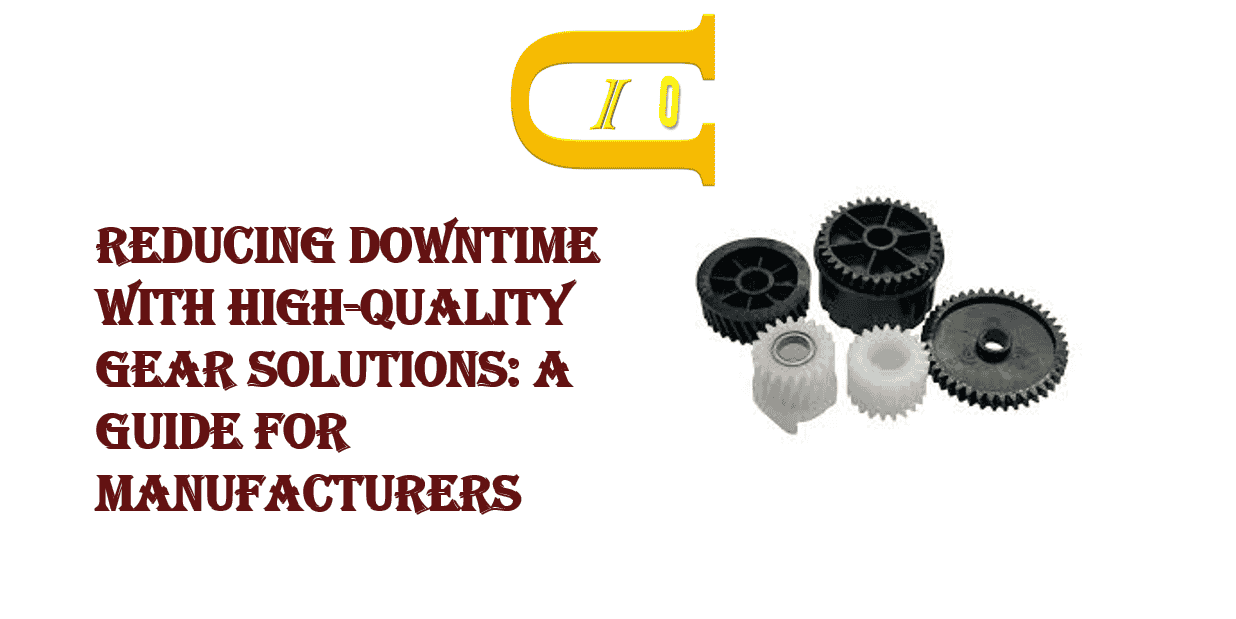Reducing Downtime with High-Quality Gear Solutions- A Guide for Manufacturers

Reducing Downtime with High-Quality Gear Solutions: A Guide for Manufacturers
In the competitive world of manufacturing, minimizing downtime is crucial for maximizing productivity, cutting operational costs, and maintaining a healthy bottom line. One of the most effective ways to achieve this is by investing in high-quality gear solutions. Gear systems are the backbone of many manufacturing processes, and their performance directly impacts the efficiency of production lines. This article will explore how maintaining gear systems, enhancing their reliability, and focusing on longevity can significantly reduce downtime and lower long-term operational costs for manufacturers.
Table of Contents
The Cost of Downtime in Manufacturing
Before diving into how high-quality gears can reduce downtime, it’s important to understand just how expensive downtime can be for manufacturers. Studies have shown that downtime costs can range from $1,000 to $250,000 per hour, depending on the industry, scale of operations, and specific machinery involved. In sectors like automotive manufacturing, food processing, or electronics assembly, where high-volume and just-in-time production are essential, downtime can result in missed production targets, delays in customer deliveries, and a loss of revenue.
Downtime also extends beyond direct financial costs. It can damage your brand's reputation, affect employee morale, and sometimes even lead to more serious long-term operational inefficiencies. Therefore, ensuring that gear systems run reliably and efficiently is one of the most effective ways to mitigate these risks.
The Role of Gears in Manufacturing
Gears are integral components in various machinery, from conveyors and pumps to presses and CNC machines. They are responsible for transmitting motion and force between machine parts, which ensures that manufacturing processes run smoothly. When gears fail or degrade, it can cause an entire production line to halt, resulting in costly repairs and a lengthy recovery time.
By focusing on high-quality gear solutions and establishing a solid maintenance regimen, manufacturers can significantly reduce the likelihood of unexpected breakdowns and minimize downtime.
Maintenance: The Key to Preventing Failures
Effective maintenance is the first step in reducing downtime caused by gear failure. Regularly inspecting and maintaining gear systems ensures that potential issues are identified and addressed before they lead to catastrophic failures. Here are some key maintenance practices that can help prolong the lifespan of gears and prevent unexpected downtime:
1. Scheduled Inspections
- Regular inspections allow manufacturers to detect early signs of wear, such as misalignment, excessive backlash, or abnormal vibrations. Catching these issues early on can prevent more significant damage down the line.
2. Lubrication and Cleaning
- Proper lubrication is critical for ensuring that gears function smoothly and efficiently. Insufficient lubrication can lead to overheating, friction, and ultimately, gear failure. Regular cleaning of gears to remove contaminants also plays a vital role in maintaining their performance.
3. Monitoring and Condition-Based Maintenance
- Using vibration analysis, thermography, and oil analysis are valuable techniques for monitoring gear condition in real-time. These predictive maintenance tools can signal the need for repairs or part replacements before a failure occurs, allowing manufacturers to schedule downtime for maintenance during off-peak hours.
4. Proper Load Management
- Overloading gears can cause premature wear and failure. Manufacturers should ensure that gears are properly rated for the specific loads they will be subjected to, and that load distribution is optimized to prevent undue stress.
Reliability: The Backbone of Efficient Operations
Reliability is another key factor in minimizing downtime. When manufacturers invest in high-quality gear solutions from reputable manufacturers, they are ensuring that their equipment will perform as expected for longer periods without frequent breakdowns. High-reliability gears are designed to withstand the rigors of continuous, high-performance operations, even under challenging conditions.
Choosing Reliable Gear Suppliers
Working with trusted gear manufacturers who provide reliable, tested gear solutions is essential. Be sure to evaluate suppliers based on their track record for quality, the materials they use, and their ability to offer tailored solutions for your specific needs. High-quality materials such as hardened steel, carbon fiber, or advanced composites provide enhanced durability, wear resistance, and performance in a wide range of industrial applications.
The Role of Advanced Gear Technologies
Emerging technologies, like smart gears integrated with IoT (Internet of Things) sensors, can further enhance the reliability of gear systems. These sensors provide real-time data on temperature, load, vibration, and other critical parameters, which can help predict potential failures and guide maintenance decisions. By investing in such technology, manufacturers can improve their operational reliability and reduce unexpected downtime.
Longevity: Reducing Replacement Costs
Longevity is an important factor that goes hand-in-hand with maintenance and reliability. When gears last longer, it reduces the frequency of replacements, which can be costly both in terms of parts and labor. A longer-lasting gear system means fewer production interruptions, lower maintenance costs, and a better return on investment.
1. Material Selection
- High-quality gears made from durable materials are more likely to last longer and perform reliably over time. Choosing gears made from materials with high wear resistance and corrosion resistance will improve the longevity of the system.
2. Upgrading Gear Systems
- As manufacturing technology advances, upgrading to more efficient and durable gear systems can extend the overall lifespan of your machinery. While initial costs may be higher, the long-term savings from reduced downtime and maintenance often outweigh the investment.
3. Improved Design
- Gears with advanced design features, such as optimized tooth profiles, can help improve their operational efficiency and reduce the wear and tear that leads to premature failure. Work closely with gear manufacturers who offer custom engineering solutions that fit your unique operational needs.
Conclusion: Investing in Quality for Reduced Downtime
For manufacturers looking to reduce downtime and improve overall operational efficiency, investing in high-quality gear solutions is a wise decision. Regular maintenance, ensuring reliability through trusted suppliers and advanced technologies, and focusing on longevity through superior materials and design all play essential roles in minimizing unplanned downtime.
By proactively addressing these factors, manufacturers can extend the life of their gear systems, reduce the frequency and severity of repairs, and ultimately lower operational costs. In the long run, high-quality gear systems contribute to a more efficient, cost-effective, and competitive manufacturing process.
Related Products
Here are some relevant facts and statistics that can strengthen the article on reducing downtime with high-quality gear solutions for manufacturers:
1. Cost of Downtime in Manufacturing
- According to Infolink's study, the average cost of downtime for manufacturers can range from $1,000 to $250,000 per hour, depending on the industry and type of machinery involved.
- A 2016 Aberdeen Group report states that the average cost of downtime for manufacturers was around $260,000 per hour for large-scale enterprises.
- In a study by PwC, it was reported that 20% of manufacturing firms lose at least 5% of annual revenue due to unplanned downtime.
2. Impact of Gear Failures
- According to the U.S. Department of Energy, up to 80% of industrial maintenance costs are driven by the failure of critical components, including gears, in equipment.
- A study by the International Society of Automation (ISA) found that predictive maintenance and condition-based monitoring can reduce maintenance costs by as much as 25% to 30% and cut downtime by up to 70%.
3. Maintenance and Reliability Statistics
- A report by the Plant Engineering Journal revealed that the average manufacturing plant spends between 10% to 20% of its operating budget on maintenance and equipment repairs. Investing in high-quality parts and effective maintenance systems can significantly reduce these costs.
- According to McKinsey, smart manufacturing technologies, such as IoT-based sensors and AI-driven predictive maintenance, can improve reliability and reduce unplanned downtime by as much as 50% in some industries.
- A study by SKF found that 88% of companies implementing condition-based or predictive maintenance saw improvements in equipment reliability and a 10-30% reduction in maintenance costs.
4. Longevity and Gear Life
- A report from the European Gear Manufacturers Association (EUROG) indicates that high-quality gears made from advanced materials (e.g., high-strength steel, carbon fiber, or composite alloys) can last up to 50% longer compared to standard gears when properly maintained.
- According to the American Gear Manufacturers Association (AGMA), properly selected and maintained gears can have a service life of 10-20 years, whereas poorly maintained gears may fail within 3-5 years.
5. Industry Adoption of Advanced Gear Technologies
- By 2025, the global predictive maintenance market is expected to reach $23.5 billion, growing at a CAGR (Compound Annual Growth Rate) of 28.4% from 2020 to 2025, highlighting the increasing focus on advanced technologies for reducing downtime and improving operational efficiency.
- A report from the World Economic Forum highlighted that manufacturers adopting Industry 4.0 technologies like IoT, AI, and real-time monitoring have experienced up to 25% improvements in operational efficiency and 30% reductions in downtime.
